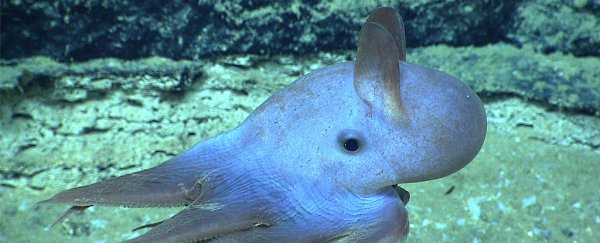If there were a competition for the most adorable ocean creature, the dumbo octopus - named for the ear-like fins with which it swims - would be right up there.
And now, for the first time, you can see an even-more-adorable newborn dumbo octopus thanks to researchers who have caught the little cephalopod on camera.
It was back in 2005 when Tim Shank from Woods Hole Oceanographic Institution, aboard the Deep Atlantic Stepping Stones expedition, first came across what looked like small tan golf balls attached to coral branches in the Northwest Atlantic, about 2,000 kilometres (1.2 miles) down.
He collected several samples with the expedition's remotely operated vehicle to try to figure out what they were.
"With each successive collection, it became apparent that this was some sort of an egg case," he said.
"The first few were open and empty, the next two contained a white gelatinous mass within, and the final collection yielded the specimen described in the paper."
He put it in a bucket of water in the ship's cold room, noting that the egg, about 14 by 19 millimetres, was unbroken.
However, by the time he went to remove the bucket from the cold room to examine the egg more closely, it had started to hatch, the inhabitant wriggling its way out posterior-first, followed by its fins and its tentacles.
"Once the fins were observed while it was still in the bucket, it was clear that it was a 'dumbo' octopod," said curator Elizabeth Shea from the Delaware Museum of Natural History.
Initially, the baby octopus didn't move much after hatching, which probably happened prematurely due to the stress of being collected. But even though it hatched too early, the octopus was fully formed, the researchers found.
After its initial torpor, it started moving about, during which time the researchers observed and filmed it. Although juvenile dumbo octopuses have been observed in the wild, this was the first time scientists had observed a live hatching.
Dumbo octopuses (Grimpoteuthis) live in the deep ocean, at depths of 3,000 to 4,000 metres (9,800 to 13,100 feet), according to the Smithsonian, which means their natural habitat is difficult for humans to access. This egg presented a rare opportunity.
After they had observed the cephalopod for two hours, the research team fixed the octopus, egg case, and membrane for long-term storage, and examined the octopus in closer detail, taking MRI scans to study the anatomy.
This confirmed the octopus's genus as Grimpoteuthis, although the exact species is still unknown.
The researchers also found that the octopuses are fully formed from the very beginning, equipped with everything they need to start independently living in their environment.
"The virtual exploration and 3D reconstruction of the internal anatomy of this deep-sea creature was particularly revealing," said zoologist Alexander Ziegler from Rheinische Friedrich-Wilhelms-Universität Bonn in Germany.
"I was impressed by the complexity of the central nervous system and the relative size of fins and the internal shell. However, for me as a zoologist, the most interesting aspect of our discovery remains the close interaction between the dumbo egg and the deep-sea coral host."
The tiny octopus's fin cartilage, internal cartilage shell, and musculature was strong enough to start swimming, and its tentacles had a number of well developed suckers.
It also had the ability to see its environment, with fully developed eyes, and an internal yolk sac providing sustenance for a short time until the hatchling can catch its first meal.
"We knew that adults are predominantly benthopelagic, that females lay eggs on the ocean bottom, and that octopod eggs come in a variety of sizes, colors, and textures," Shea said.
"Our work connects the dots between a particular egg, a particular coral, and a particular octopod."
The team's paper has been published in Current Biology.
